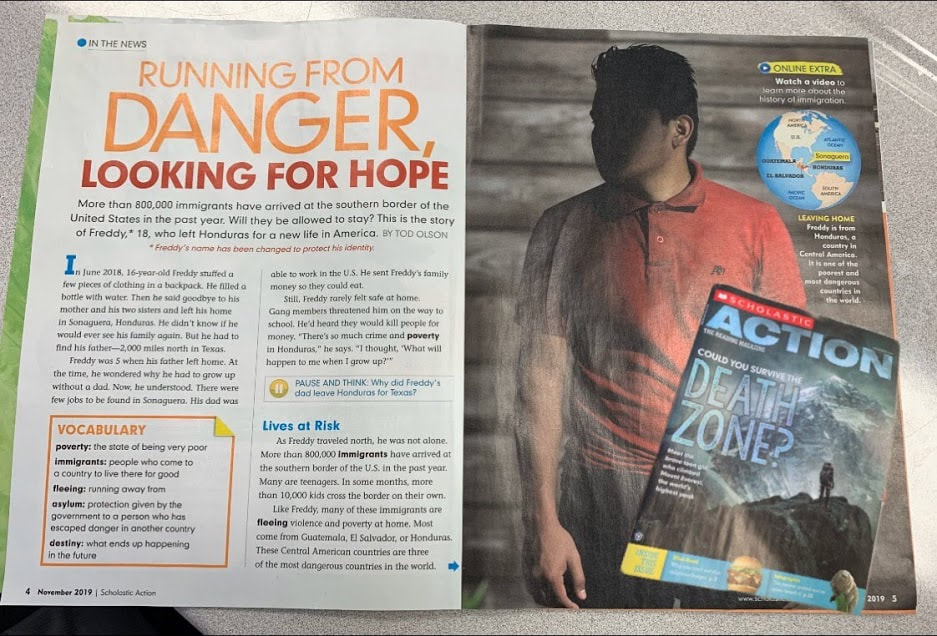Part I
In September 2019 - I shared a blog post on how I structure my ESL lessons for HS newcomer ELs. If you haven't read it, I encourage you to do so! Click here for the blog post.
The Scholastic Action magazine, which is one of the resources I use during guided reading, always includes compelling topics my students find very interesting. The November issue includes an article very close to my heart - "an immigrant story"! Running from Danger, Looking for Hope - is the story of Freddy, an immigrant young man from Honduras. I was so excited about planning this lesson and looking forward to sharing it with my students. To increase the understanding of the immigration topic, I assigned students' group projects on the same topic but using picture books as a resource for the information. The picture books we used were:
Working in Small Groups
I only read the Action magazine story with 3 groups, my SIFE students worked on their picture book project with me during guided reading.
For my beginning level students, we started by discussing and brainstorming why we think the character's face was not visible and why the author decided to change the character's original name. Students had very good discussions including documentation, gangs, trouble, embarrassment, etc. After a brief discussion, I read the first paragraph aloud as they tracked the text in their magazine. After reading aloud, I invited students to read with me. Choral reading is a great strategy because it doesn't put students on a spot and/or in a position where they could be made fun or for not reading correctly. After chorally reading, students used a highlighter to highlight words they understood - these could be words they already know in English and/or cognates (words in two languages that share a similar meaning, spelling, and pronunciation). For more information on active reading strategies, read this article! Students provided the following words:
This is the paragraph students created with my support:
Students heard me read the paragraph aloud, then they practiced with their partner. Once they were comfortable, students volunteered to read to the group.

I LOVE creating a comfortable environment where my students are willing to take risks and practice speaking, reading, and writing.
While students were practicing, I snapped this picture of Emerzon whose smile warmed my heart because it is evident that he is happy and very comfortable in our classroom. SIFE in Small Group Instruction
I have two students who are SIFE. If you are not aware of this term, I encourage you to read this check out this site and find out more about the term and get resources to better serve your SIFE students.
I like using picture books to support my students with English language development because the images can provide the scaffolding they need to understand the text. Since our topic this week was "immigration/Refugees", I assigned my SIFE students the book Dreamers/Soñadores by Yuyi Morales. I started by prompting questions for students to answer with yes/no. The questions are very simple but it sets a great start for students to feel that they CAN do the expected work even though it's in a language they don't have YET.
Based on the pictures above, I asked the following questions:
After modeling speaking sentences of what I see in pictures, I have students echo the sentence. As we say it, we point to the image so we make a connection with what we're saying. One of my students immediately added his own sentence saying that the character was confused because she didn't understand!! After talking about the picture, we began writing. This is what our written sentences looked like.
She has a baby.
They live in Mexico.
They walked to the USA.
(we knew this because we pulled up a map to see how Mexico is beside the USA)
She is confused.
She is in trouble.
Our work kept going for the whole book. This work took several days but everyday students did work to create and write these sentences.
After writing a sentence, we practice reading it until we knew how to read it without support. We read one sentence at a time, then adding the sentences together for fluency. I can tell students felt very proud of themselves for being able to do this work and for being able to read, speak, and understand s story in English. Students added their own illustration to their sentences. When their work is complete, I will be adding it to the post...stay tuned! *(check out this blog post for follow up)* I hope you enjoyed reading this part one of this post - Part II will be all about the independent work my students did with the picture books mentions above...their work and presentations were powerful and very emotional...You will want to read it!! Thank you for reading!
0 Comments
Your comment will be posted after it is approved.
Leave a Reply. |
Categories
All
Archives
May 2024
|










